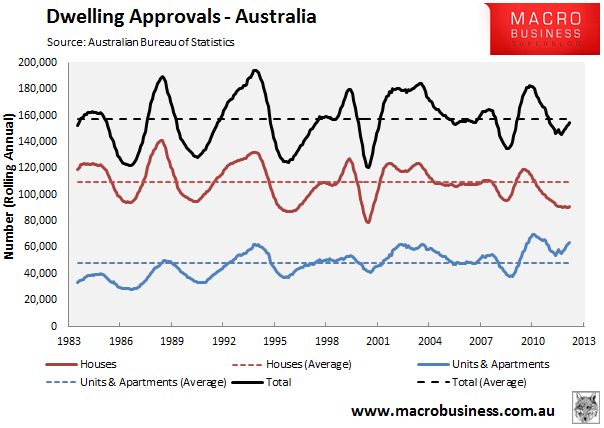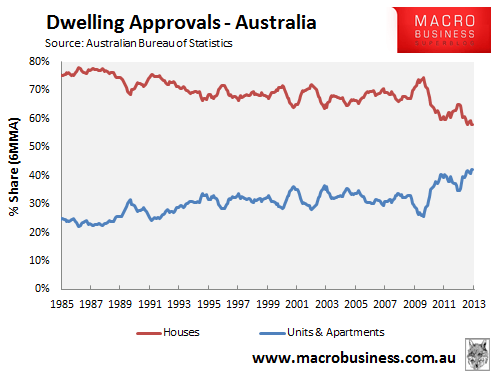
Much has been written about Australia’s new found embrace of apartment living, whereby more and more Australians are supposedly “chosing” the convenience of inner-city apartment living over a traditional detached house in the suburbs.
Certainly, recent construction data released by the Australian Bureau of Statistics seems to support this contention, with apartment approvals booming as detached house approvals languish near recessionary levels (see next chart).

The percentage share of dwelling approvals going to apartments also hit a record high of 42% in the 6-months to February 2013 (see next chart).

However, new research released by BIS Shrapnel argues that much of the recent apartment boom has been driven by the rise of the “echo-boomer” generation – i.e. 20-34 year-old children of baby boomers – and that demand for apartments could soon slow significantly as this generation begins to raise families. From Property Observer:
The age bracket, which it labels the echo baby boomers, has been driving apartment occupancy for the last 10 years, according to its Emerging Trends in Residential Market Demand report.
At the same time, it found there has not been any major evidence of an increase in the rate of downsizing by those aged 65 and over.
The age-bracket has been over-represented in demographic make-up of Australia as the children of the baby boomer generation grow up while overseas migration is strong in that age bracket.
“The growth in the 20-to-34 year old group has fuelled occupancy of units and apartments in the inner and middle suburbs of the capital cities over the past decade, mainly as renters,” says BIS Shrapnel senior manager Angie Zigomanis.
“However, as this group increasingly moves into their late 30s and early 40s in the coming decade and enters their next life stage, the question is whether they will still live in medium and high density dwellings.”
According to the 2011 Census, around 63% of households with a household head aged 20 to 34 years old lived in detached houses, but this figure is 80% for households where the household head is aged 35 to 49.
And 71% of households among 35 to 49 year olds were families with children, compared with only 39% of 20 to 34-year-old households.
“Assuming the current 20 to 34 year olds in multi unit dwellings move on to separate houses, as has already been evident among 35 to 49-year-old households, then this will translate to higher demand for new detached houses,” says Zigomanis.
Other ‘experts’ seem to agree with BIS Shrapnel’s assessment:
Professor Bill Randolph of the University of NSW [believes] “flats were never intended for family use. One and two bedders don’t make great family homes,” he said.
Mr Randolph said while apartment living had become more acceptable for families, the majority of residents in flats saw their accommodation as a “short-term solution”. Notwithstanding issues of affordability, a concern for space – particularly with a growing family – usually pushes tenants on to bigger pastures, he said.
Urbis regional director Tim Blythe said affordability issues and a lack of new housing in greenfield areas meant continued demand for medium or high-density living, even if residents wanted properties with more space.
“Greenfield living isn’t as easy as it used to be, it’s not as accessible,” he said. He said high-density housing was still sprouting in suburban areas to service housing demand across all sectors.
Of course, one of the reasons why greenfield housing is less accessible these days is because fringe land prices have been pushed-up by urban consolidation policies pursued by Australia’s state governments, as well as an overall failure to fund and provide infrastructure to new housing estates.
It’s also interesting to note that similar claims about the increasing desirability of apartment living have also been made in the US. Yet, analysis of the most recent Census showed that the overwhelming majority of Americans still chose to settle in the suburbs and that reports of the death of suburbia are wildly inaccurate. I suspect similar results would be found in Australia were supply set by consumer preferences, rather than the preferences of central planners.

